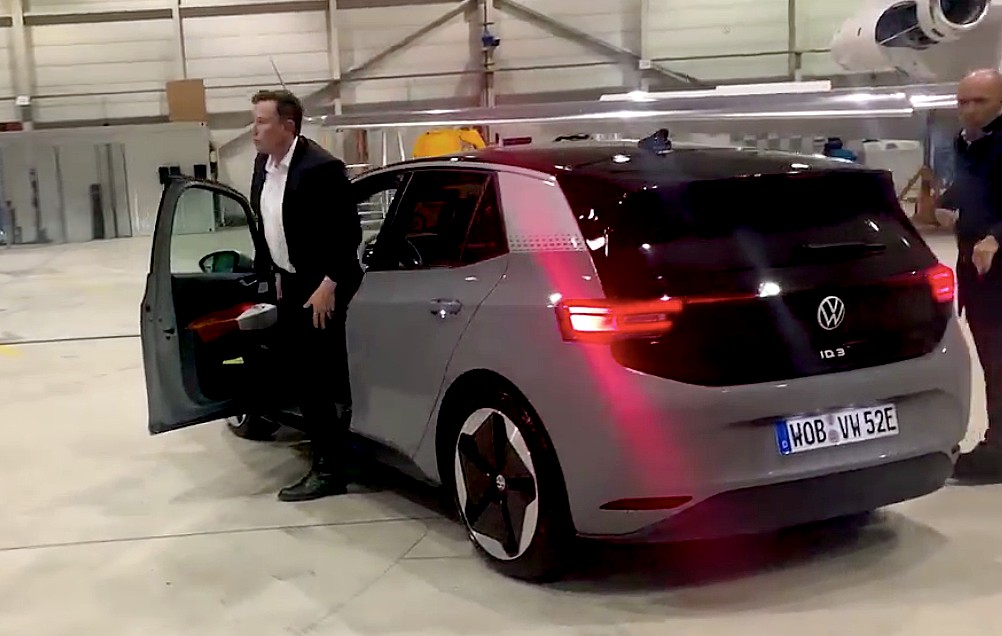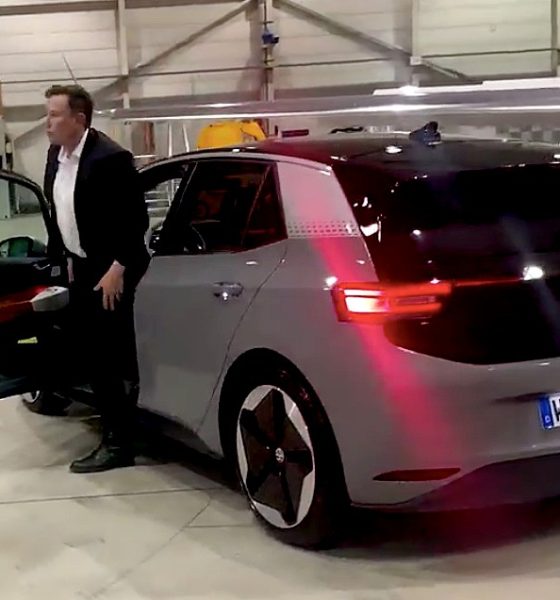

News
Volkswagen shares Elon Musk’s test drive of the VW ID.3: ‘It’s pretty good’
One of the more surprising elements in Elon Musk’s recent visit to Germany was his meeting with Volkswagen Group executive Herbert Diess, who hosted the Tesla CEO at the Braunschweig Airport. During their two-hour meeting, the two electric car advocates took a drive in the ID.3, Volkswagen’s first EV from its MEB platform. The news came as a pleasant surprise to the electric car community, many of whom were interested to see Elon Musk’s insights on the ID.3, a car that could rise alongside the Model 3 in the mainstream vehicle market.
Fortunately, a video of Elon Musk’s Volkswagen ID.3 test drive was recently shared by Herbert Diess in his LinkedIn profile. The short video, which was also posted by the Volkswagen Group’s official Twitter account, featured Musk and Diess engaging in friendly conversation while the former was test driving the ID.3. As it turned out, Musk seemed to be pretty optimistic about the vehicle, at one point stating that the ID.3’s steering was “pretty good” for a non-sporty electric car.
Quite amusingly, the recently-shared video included segments of Herbert Diess setting Musk’s expectations about the ID.3 by reminding the Tesla CEO that the hatchback was a mainstream car and “not a race machine.” Laughing in response, Musk lightly stated that he “just wanted to see what the acceleration is like.” Musk could later be seen seemingly flooring the ID.3 while jokingly asking Diess “What’s the worst that could happen?”
In the few segments of the test drive featured in the clip, it could be seen that Musk inquired about several aspects of the ID.3, such as its battery pack and its driver-assist features. Diess, for his part, stated that the ID.3 is equipped with German state-of-the-art lane-keeping and emergency assist systems. The clip ended with Elon Musk and Herbert Diess getting out of the ID.3, with the Tesla CEO seemingly looking over some details of the mainstream EV. The ID.4, an all-electric crossover, could be seen nearby as well.
Diess later commented in his post with some new details about Musk’s Volkswagen ID.3 test drive. According to the Volkswagen Group executive, Musk was a bit critical of the ID.3’s torque at higher speeds. Diess also told Musk that for a true sports car experience, the Tesla CEO should try out the Porsche Taycan, an all-electric high-performance EV that Musk has openly supported in the past.
“Thanks for the visit, Elon! Hope you like the video. It was great driving the ID.3 with you! You were just quite critical with the available torque at higher speed. I told you: ‘Yes, we are on the runway – but no need for takeoff – it’s not a sports car.’ For this, you should try our Porsche Taycan. Looking forward to our next meeting!” Diess wrote.
Elon Musk and Herbert Diess have openly supported each other’s endeavors in the past, with the Tesla CEO recently stating during an interview at Gigafactory Berlin that companies like Volkswagen are putting in a lot of real work to get EVs to the mainstream market. While responding to a rather critical report on the Volkswagen Group executive last year, Musk noted on Twitter that “Herbert Diess is doing more than any big carmaker to go electric. The good of the world should come first. For what it’s worth, he has my support.”
Diess, for his part, has also openly defended Musk. Last October alone, reporters suggested that while the Model 3 was successful, they still view Tesla as a “niche” carmaker capable of making low-volume cars but out of its league in the mass market segment. Diess promptly came to Tesla’s defense, stating that the American carmaker is not a “niche” company in any way. “Tesla is not niche. The Model 3 is a large-series model and they are one of the biggest manufacturers of electric-car batteries. We have a lot of respect for Tesla. It’s a competitor we take very seriously,” the Volkswagen Group executive said.

News
Tesla FSD fleet is nearing 7 billion total miles, including 2.5 billion city miles
As can be seen on Tesla’s official FSD webpage, vehicles equipped with the system have now navigated over 6.99 billion miles.

Tesla’s Full Self-Driving (Supervised) fleet is closing in on almost 7 billion total miles driven, as per data posted by the company on its official FSD webpage.
These figures hint at the massive scale of data fueling Tesla’s rapid FSD improvements, which have been quite notable as of late.
FSD mileage milestones
As can be seen on Tesla’s official FSD webpage, vehicles equipped with the system have now navigated over 6.99 billion miles. Tesla owner and avid FSD tester Whole Mars Catalog also shared a screenshot indicating that from the nearly 7 billion miles traveled by the FSD fleet, more than 2.5 billion miles were driven inside cities.
City miles are particularly valuable for complex urban scenarios like unprotected turns, pedestrian interactions, and traffic lights. This is also the difference-maker for FSD, as only complex solutions, such as Waymo’s self-driving taxis, operate similarly on inner-city streets. And even then, incidents such as the San Francisco blackouts have proven challenging for sensor-rich vehicles like Waymos.
Tesla’s data edge
Tesla has a number of advantages in the autonomous vehicle sector, one of which is the size of its fleet and the number of vehicles training FSD on real-world roads. Tesla’s nearly 7 billion FSD miles then allow the company to roll out updates that make its vehicles behave like they are being driven by experienced drivers, even if they are operating on their own.
So notable are Tesla’s improvements to FSD that NVIDIA Director of Robotics Jim Fan, after experiencing FSD v14, noted that the system is the first AI that passes what he described as a “Physical Turing Test.”
“Despite knowing exactly how robot learning works, I still find it magical watching the steering wheel turn by itself. First it feels surreal, next it becomes routine. Then, like the smartphone, taking it away actively hurts. This is how humanity gets rewired and glued to god-like technologies,” Fan wrote in a post on X.
News
Tesla starts showing how FSD will change lives in Europe
Local officials tested the system on narrow country roads and were impressed by FSD’s smooth, human-like driving, with some calling the service a game-changer for everyday life in areas that are far from urban centers.

Tesla has launched Europe’s first public shuttle service using Full Self-Driving (Supervised) in the rural Eifelkreis Bitburg-Prüm region of Germany, demonstrating how the technology can restore independence and mobility for people who struggle with limited transport options.
Local officials tested the system on narrow country roads and were impressed by FSD’s smooth, human-like driving, with some calling the service a game-changer for everyday life in areas that are far from urban centers.
Officials see real impact on rural residents
Arzfeld Mayor Johannes Kuhl and District Administrator Andreas Kruppert personally tested the Tesla shuttle service. This allowed them to see just how well FSD navigated winding lanes and rural roads confidently. Kruppert said, “Autonomous driving sounds like science fiction to many, but we simply see here that it works totally well in rural regions too.” Kuhl, for his part, also noted that FSD “feels like a very experienced driver.”
The pilot complements the area’s “Citizen Bus” program, which provides on-demand rides for elderly residents who can no longer drive themselves. Tesla Europe shared a video of a demonstration of the service, highlighting how FSD gives people their freedom back, even in places where public transport is not as prevalent.
What the Ministry for Economic Affairs and Transport says
Rhineland-Palatinate’s Minister Daniela Schmitt supported the project, praising the collaboration that made this “first of its kind in Europe” possible. As per the ministry, the rural rollout for the service shows FSD’s potential beyond major cities, and it delivers tangible benefits like grocery runs, doctor visits, and social connections for isolated residents.
“Reliable and flexible mobility is especially vital in rural areas. With the launch of a shuttle service using self-driving vehicles (FSD supervised) by Tesla in the Eifelkreis Bitburg-Prüm, an innovative pilot project is now getting underway that complements local community bus services. It is the first project of its kind in Europe.
“The result is a real gain for rural mobility: greater accessibility, more flexibility and tangible benefits for everyday life. A strong signal for innovation, cooperation and future-oriented mobility beyond urban centers,” the ministry wrote in a LinkedIn post.
News
Tesla China quietly posts Robotaxi-related job listing
Tesla China is currently seeking a Low Voltage Electrical Engineer to work on circuit board design for the company’s autonomous vehicles.

Tesla has posted a new job listing in Shanghai explicitly tied to its Robotaxi program, fueling speculation that the company is preparing to launch its dedicated autonomous ride-hailing service in China.
As noted in the listing, Tesla China is currently seeking a Low Voltage Electrical Engineer to work on circuit board design for the company’s autonomous vehicles.
Robotaxi-specific role
The listing, which was shared on social media platform X by industry watcher @tslaming, suggested that Tesla China is looking to fill the role urgently. The job listing itself specifically mentions that the person hired for the role will be working on the Low Voltage Hardware team, which would design the circuit boards that would serve as the nervous system of the Robotaxi.
Key tasks for the role, as indicated in the job listing, include collaboration with PCB layout, firmware, mechanical, program management, and validation teams, among other responsibilities. The role is based in Shanghai.
China Robotaxi launch
China represents a massive potential market for robotaxis, with its dense urban centers and supportive policies in select cities. Tesla has limited permission to roll out FSD in the country, though despite this, its vehicles have been hailed as among the best in the market when it comes to autonomous features. So far, at least, it appears that China supports Tesla’s FSD and Robotaxi rollout.
This was hinted at in November, when Tesla brought the Cybercab to the 8th China International Import Expo (CIIE) in Shanghai, marking the first time that the autonomous two-seater was brought to the Asia-Pacific region. The vehicle, despite not having a release date in China, received a significant amount of interest among the event’s attendees.








